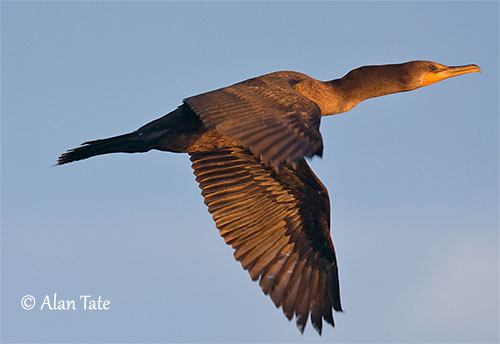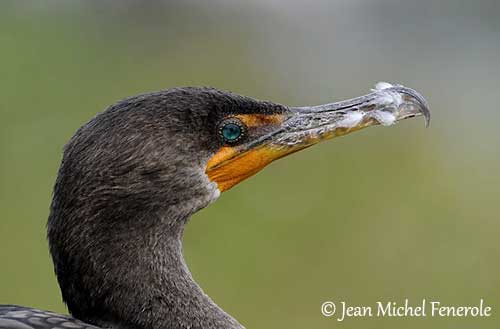
Fr: Cormoran à aigrettes
Ang: Double-crested Cormorant
All: Ohrenscharbe
Esp: Cormorán Orejudo
Ita: Cormorano orecchiuto
Nd: Geoorde Aalscholver
Sd: öronskarv
Photographers:
Jean Michel Fenerole
Photos d’Oiseaux du monde
Tom Grey
Tom Grey's Bird Pictures & Tom Grey's Bird Pictures 2
Ken Havard
My Bird Gallery & Flickr gallery 1 & Flickr gallery 2
Otto Plantema
Trips around the world
Alan & Ann Tate
AA Bird Photography
Text by Nicole Bouglouan
Sources:
HANDBOOK OF THE BIRDS OF THE WORLD vol 1 by Josep del Hoyo-Andrew Elliot-Jordi Sargatal - Lynx Edicions - ISBN: 8487334105
FIELD GUIDE TO THE BIRDS OF NORTH AMERICA - National Geographic Society - ISBN: 0792274512
All About Birds (Cornell Lab of Ornithology)
The Birds of North America online
Bird Web (Seattle Audubon Society)
Wikipedia, the free encyclopaedia
What Bird-The ultimate Bird Guide (Mitchell Waite)
National Park Service – Channel Islands
The Wildlife Society - The rise of double-crested cormorants: Too much of a good thing?
Page family Phalacrocoracidae
Summary cards
Double-crested Cormorant
Phalacrocorax auritus
Suliformes Order – Phalacrocoracidae Family
INTRODUCTION:
The Double-crested Cormorant is a widespread North American cormorant which range extends from Aleutian Islands in Alaska down to Mexico.
This species nests on a variety of natural and artificial supports including cliff ledges, trees and shrubs, ground and human structures. They usually breed in colonies.
The Double-crested Cormorant feeds on various fish species caught by underwater chase, during which the bird is propelled by its powerful webbed feet.
This species is currently not threatened. The population is increasing and expanding its range, due to construction of reservoirs in inland areas. Control numbers has been adopted in several regions, with variable success.

DESCRIPTION OF THE BIRD:
Biometrics:
Length: 76-91 cm
Wingspan: 137 cm
Weight: 710-2100 g
The Double-crested Cormorant in breeding plumage is glossy black with green tinge on the upperparts and grey wash on the upperwing. Head and neck may sometimes show white filoplumes. There is a long, shaggy crest of upcurved feathers behind each eye. The crest is white in Alaskan cormorants, and black in other regions.
We can see a conspicuous bright orange patch of bare skin around face and chin.
The hooked bill is grey with pale and dark vertical bands on sides of both mandibles, but the culmen is dark grey. The mouth is pale cobalt-blue. The eyes are green to turquoise-blue, surrounded by narrow eyering of same colour. Legs and webbed feet are blackish grey.
Male and female are similar, but the female is slightly smaller than male.
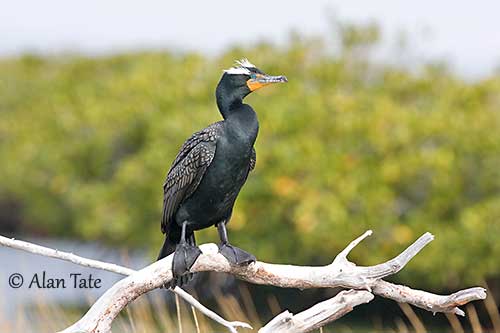
The non-breeding adult has duller blackish plumage and lacks the crest.
The juvenile is much browner than the non-breeding adult. The underparts show variable amount of whitish. Most juveniles have whitish foreneck and breast, and mostly brown belly and flanks, whereas others are all black.
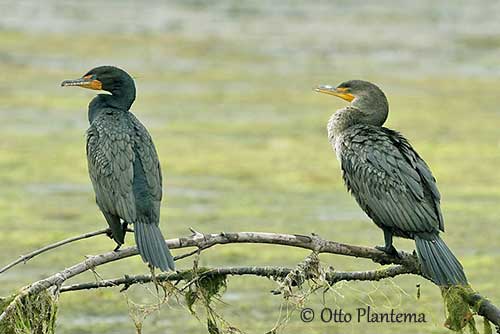
SUBSPECIES AND RANGE:
The Double-crested Cormorant has five subspecies that differ in size, shape and crest colour.
P.a. cincinatus is found in Aleutian Islands (E from Unalaska) to Alexander Archipelago in SE Alaska. It winters S to British Columbia (SW Canada).
This race is the largest. It has long, white crest, but in non-breeding plumage, it has bright orange yellow skin on upper lores.
P.a. albociliatus is found in Vancouver Island down coast to Gulf of California, and inland in Washington, Oregon, Nevada, California and Arizona.
This race is slightly paler greyish-bronze than nominate on mantle and upperwing. The long crest shows variable amount of white.
P.a. auritus (described above) is present in E and C of North America, from Gulf of Saint Lawrence S to Cape Cod, and W to Alberta and Utah. It winters from middle of Atlantic coast to Gulf of Mexico.
P.a. floridanus is found in SE USA (North Carolina and Florida) S to Cuba and Yucatán Peninsula.
P.a. heuretus occurs in San Salvador (S Bahamas).
HABITAT:
The Double-crested Cormorant can be found in a variety of aquatic habitats such as rocky coasts, mangroves, swamps, lagoons, estuaries, rivers, small inland ponds or lakes and large reservoirs.
It commonly roosts or perches on rocks, sandbars and trees near the foraging areas.
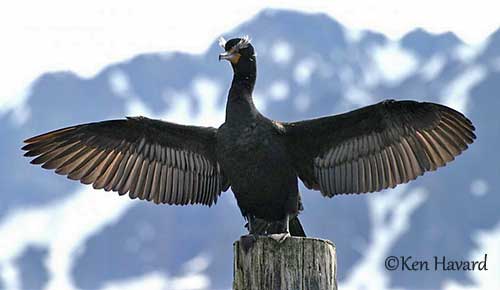
CALLS AND SONGS: SOUNDS BY XENO-CANTO
The Double-crested Cormorant is usually silent away from the colonies. During the breeding season, it produces deep, guttural grunts. These sounds are uttered when the bird takes off or lands, but also while mating or during aggressive displays.
BEHAVIOUR IN THE WILD:
The Double-crested Cormorant feeds primarily on various species of fish. It dives from the surface and pursues the prey underwater. It is propelled by the powerful webbed feet. The fish is caught with the bill, rarely speared. While surfacing, the cormorant flips the fish into the air in order to turn it and swallow it head first.
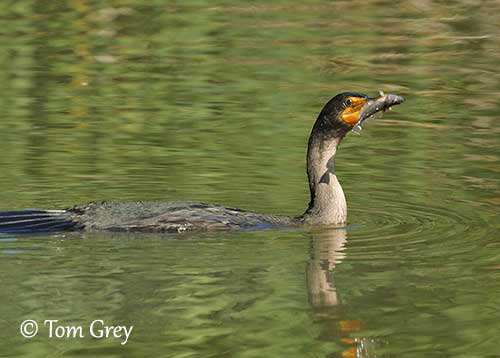
Like all the cormorants of genus Phalacroracidae, this species dries its wings after diving. It can be seen perched on branches near water with spread wings. They may fish co-operatively, with sometimes flocks of 1000s birds together.
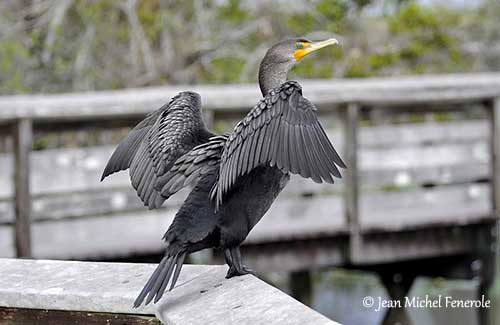
They also feed intensively at fish farms, and during the winter, large flocks of more than 60,000 cormorants can frequent these areas at Mississippi Delta. The direct predation impact is important for the industry, but losses at pond level are also experienced by individual farmers. The best strategy used by Wildlife Services is roost harassment efforts, in order to move the birds to more distant roosts. These programs have been successful in removing cormorants foraging on the nearby farms.
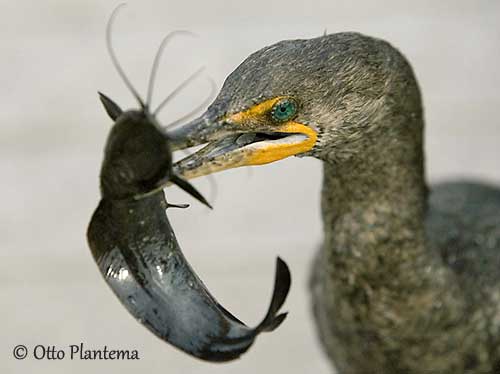
The Double-crested Cormorant breeds usually in colonies, sometimes mixed with other wading bird species. Displays are observed at the beginning of the breeding season. The male displays to female on water by splashing with wings, swimming in zigzag, diving and bringing up pieces of vegetation. It also displays at nest-site, crouching and vibrating its wings. These displays are accompanied by calls. Both adults share the nesting duties.
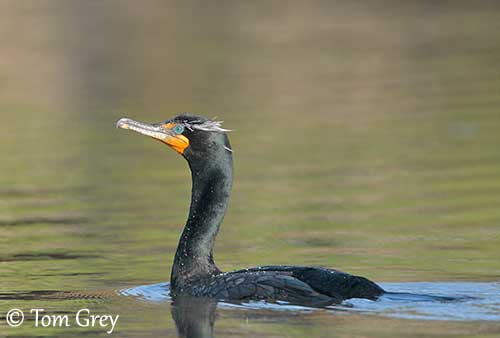
The Double-crested Cormorant of northern and inland populations is migratory. Some in Florida and on Pacific Coast may be permanent residents, but most are migratory.
They migrate in flocks and often follow coastlines or rivers. They travel by day, often forming a V-shaped formation. The flight is strong and direct. It also soars on thermals.
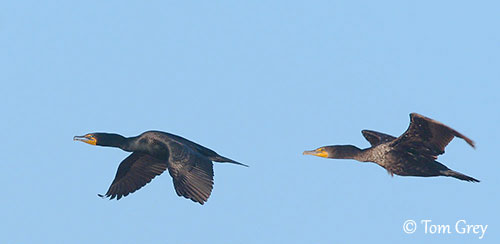
REPRODUCTION OF THIS SPECIES:
The breeding season varies with the latitude, with the egg-laying in December/January in California, and late April/early May in British Columbia.
The Double-crested Cormorant usually breeds for the first time at 3 years old. It nests in colonies on sea-cliffs, or in trees near or over water, or on the ground on islands.
The nest is mainly built by the female with the materials brought by the male. It is a platform made with sticks and debris, but the cup is lined with softer materials, often seaweeds.
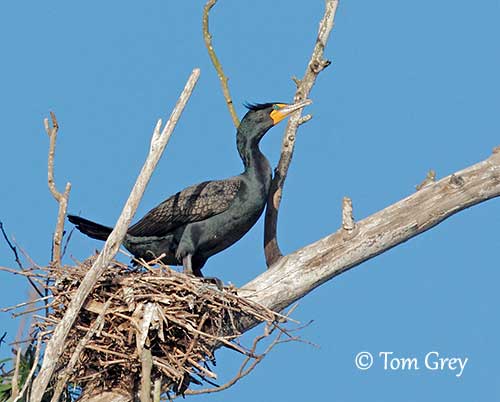
The female lays 3-4 pale bluish eggs, becoming rapidly stained. Clutches of 1-7 eggs are sometimes recorded. Both adults incubate during 28-30 days. The chicks are fed by both parents.
The young leave the nest after 3-4 weeks when the nest is on the ground. They often wander through the colony, but they return to the nest to be fed. The first flight occurs at about 5-6 weeks after hatching. They become independent at 9-10 weeks of age. This species produces a single brood per year.
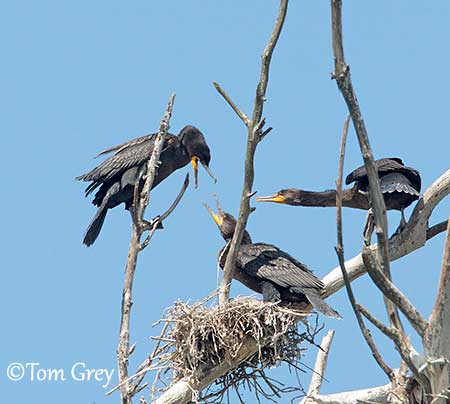
PROTECTION / THREATS / STATUS:
The population of the Double-crested Cormorant has had ups and downs, due to persecution at colonies followed by gradual increase until 1950s. Later, the numbers dropped again owing to effects of pesticides through 1960s. A new increase occurred after DDT was banned in 1972.
Today, the population is still increasing and expanding its range. Management of some nesting populations is necessary to protect the fish farms.
The population size is extremely large, and the Double-crested Cormorant is currently evaluated as Least Concern.
